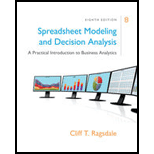
Spreadsheet Modeling & Decision Analysis: A Practical Introduction To Business Analytics, Loose-leaf Version
8th Edition
ISBN: 9781337274852
Author: Ragsdale, Cliff
Publisher: South-Western College Pub
expand_more
expand_more
format_list_bulleted
Concept explainers
Question
error_outline
This textbook solution is under construction.
Students have asked these similar questions
Distinguish between kings 11 and kings 111 reports on corporate governance
QUESTION 2
Read the following scenario carefully and then answer the question below:
Gorata Mbaiwa, the former Chief Executive Officer of Okavango (Ltd), has succeeded the
retiring chairman of the company's board of directors. Shareholders have contended that this
succession contravenes established best practices in corporate governance. Additionally, some
individuals have expressed a lack of understanding regarding the concerns raised by
shareholders.
Required:
Given the context of Gorata Mbaiwa's appointment as Chairman of Okavango (Ltd) after serving
as CEO, analyse five potential violations of corporate governance principles that would reasonably
lead to shareholder concern.
(25 marks)
QUESTION 1
The Enron scandal serves as a critical case study in corporate governance and ethics. Answer the
following questions based on your understanding of the Enron case:
The Enrol Scandal
The Enron scandal was an accounting scandal sparked by American energy company Enron
Corporation filing for bankruptcy after news of widespread internal fraud became public in
October 2001, which led to the dissolution of its accounting firm, Arthur Andersen, previously
one of the five largest in the world. The largest bankruptcy reorganization in U.S. history at that
time, Enron was cited as the biggest audit failure.
Enron was formed in 1985 by Kenneth Lay after merging Houston Natural Gas and InterNorth.
Several years later, when Jeffrey Skilling was hired, Lay developed a staff of executives that-
by the use of accounting loopholes, the misuse of mark-to-market accounting, special purpose
entities, and poor financial reporting - were able to hide billions of dollars in debt from failed
deals…
Knowledge Booster
Learn more about
Need a deep-dive on the concept behind this application? Look no further. Learn more about this topic, management and related others by exploring similar questions and additional content below.Similar questions
- 7. Compare and contrast social responsibility and sustainability.arrow_forward(8 marks) Explain three key reasons why a majority of non-executive directors on a company's board is considered good corporate governance practice. (6 marks)arrow_forward5. Company directors can face personal liability for various types of misconduct. Describe four distinct categories of malpractices for which directors can be held personally responsible. (8 marks)arrow_forward
- Describe three essential skills or areas of expertise that members of an audit committee should possessarrow_forward1. Describe any two features of stakeholder theory in relation to corporate governance. (6 mararrow_forwardAfter reading Section 5: Implementing Agile—Delivering in an Agile Environment in the Agile Practice Guide, respond to the following. Identify when and why you would use agile project management on your team project (upgrading a housing network such as a motel). If you are using a different methodology, describe the methodology and discuss why you think it is the best method to approach your project. Is there anything else that should be considered when selecting the methodology of project management?arrow_forward
- After reading Section 5: Implementing Agile—Delivering in an Agile Environment in the Agile Practice Guide, respond to the following. Identify when and why you would use agile project management on your team project (maplewood stay motel) If you are using a different methodology, describe the methodology and discuss why you think it is the best method to approach your project. Is there anything else that should be considered when selecting the methodology of project management?arrow_forwardhi can you help me making a texte about th productivity and well being of employees while reote working. can you tell why this subject is important. also talk about the shift to hybrid/ flexible work models. The lack of studies about it. that we need new data for better understanding of the subject. how can a new studies that will used a quantitative methods would help. Employers make evidence based decisions, policy makers undersatnd workers need and identify the gaps and trends Thanks you in advance!arrow_forwardA number of factors that give rise to politics in organisations” – Discuss in detail these factors and write in essay formarrow_forward
- There are many misconceptions and myths that people embrace about leaders” – Discuss in detail any six common myths. write in essay form giving introduction, body and conclusionarrow_forward. Write short notes on the following: (a). Concept of power: (b). Referent power: (c). Authority and responsibilityarrow_forwardState three advantages and three disadvantages of group decision-making.arrow_forward
arrow_back_ios
SEE MORE QUESTIONS
arrow_forward_ios
Recommended textbooks for you
 Practical Management ScienceOperations ManagementISBN:9781337406659Author:WINSTON, Wayne L.Publisher:Cengage,
Practical Management ScienceOperations ManagementISBN:9781337406659Author:WINSTON, Wayne L.Publisher:Cengage, Purchasing and Supply Chain ManagementOperations ManagementISBN:9781285869681Author:Robert M. Monczka, Robert B. Handfield, Larry C. Giunipero, James L. PattersonPublisher:Cengage Learning
Purchasing and Supply Chain ManagementOperations ManagementISBN:9781285869681Author:Robert M. Monczka, Robert B. Handfield, Larry C. Giunipero, James L. PattersonPublisher:Cengage Learning

Practical Management Science
Operations Management
ISBN:9781337406659
Author:WINSTON, Wayne L.
Publisher:Cengage,

Purchasing and Supply Chain Management
Operations Management
ISBN:9781285869681
Author:Robert M. Monczka, Robert B. Handfield, Larry C. Giunipero, James L. Patterson
Publisher:Cengage Learning

Single Exponential Smoothing & Weighted Moving Average Time Series Forecasting; Author: Matt Macarty;https://www.youtube.com/watch?v=IjETktmL4Kg;License: Standard YouTube License, CC-BY
Introduction to Forecasting - with Examples; Author: Dr. Bharatendra Rai;https://www.youtube.com/watch?v=98K7AG32qv8;License: Standard Youtube License